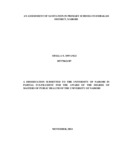| dc.contributor.author | Mwangi, Stella N | |
| dc.date.accessioned | 2014-12-29T09:43:42Z | |
| dc.date.available | 2014-12-29T09:43:42Z | |
| dc.date.issued | 2014-11 | |
| dc.identifier.uri | http://hdl.handle.net/11295/78409 | |
| dc.description | Masters Of Public Health | en_US |
| dc.description.abstract | There is a need to meet the millennium development goals, especially to achieve
universal primary education. However, there are challenges due to continual increase in
enrollment of primary school pupils. Despite the increase in enrollment, quality
education must be provided, and some factors that influence the quality of education are
water, sanitation and hygiene. Lack of water sanitation and hygiene are the leading cases
of diarrheal illnesses and helminthes infections. These diseases affect the participation,
attendance and performance of children and impede their overall growth and
development. The Government of Kenya has laid down regulations for the number of
pupils per latrine and has also published a safety standards manual for schools in Kenya
that expound on how sanitation facilities should be in schools.
The aim of this research was to find out if these regulations are being implemented in
constituency which has the highest enrolment and number of schools in Nairobi. Using
stratified sampling method a sample of 147 schools was selected for the study with a
sample randomly selected from each stratum. Data were collected by way of
questionnaires and then compared with the expected standards.
Analysis was done, among the following variables tested in the study were: level of
cleanliness, protective materials provided for the personnel who clean toilets,
availability of water in schools for hand washing among others. From the results, the
sanitation standards as defined in the schools manual have not been wholly complied
with in any school. For instance in nearly 14% of the schools girls and boys share
toilets.
There is a lot of work needed to improve the levels of sanitation in all primary schools
in the district. It was concluded from this study that majority of the schools had scarce
existence of sanitary facilities. In addition, the majority of the schools had moderate
level of sanitation as there was scarcity of water and soap in some schools at the hand
washing facilities. It was also possible to conclude that not all schools provided the
cleaners with protective equipment or clothing and this is an indication that there are
more people at risk of water borne diseases. | en_US |
| dc.language.iso | en | en_US |
| dc.publisher | University of Nairobi | en_US |
| dc.title | An assessment of sanitation in primary schools in Embakasi district, Nairobi | en_US |
| dc.type | Thesis | en_US |
| dc.description.department | a
Department of Psychiatry, University of Nairobi, ; bDepartment of Mental Health, School of Medicine,
Moi University, Eldoret, Kenya | |
| dc.type.material | en_US | en_US |

